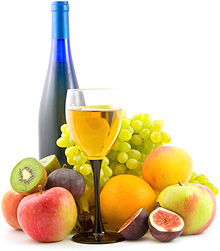 One of the things that makes wine making so much fun is that you have an opportunity to get creative. Here’s a little tip on how to make white wine with a touch of your own personal flair.
One of the things that makes wine making so much fun is that you have an opportunity to get creative. Here’s a little tip on how to make white wine with a touch of your own personal flair.
Blending certain fruits with a white grape wine can make a spectacular summertime refresher. One of my favorites is peach or apricot mixed with a Riesling grape wine. The additional fruitiness opens up both the wine’s flavor and bouquet profile.
You could make your own by getting some Riesling grape concentrate or a wine ingredient kit and adding some fresh peaches or apricots to the mix while it’s fermenting. But a better, more-controlled way of adding a fruit to a grape wine is to make the fruit into a wine of it’s own and then blend it to taste with the grape wine right before bottling.
For example, you could make an apricot wine and bottle each gallon in a gallon glass carboy. Then when a you make a grape wine (in this case Riesling) you can just take a gallon glass carboy of apricot and blend to taste with the Riesling wine at bottling time.
You may or may not need the whole gallon, or you may need to open a second gallon jug of apricot. The point being is you have complete control over how the wine is going to taste in terms of a grape-apricot blend.
———————————————————————————————————
Ed Kraus is a 3rd generation home brewer/winemaker and has been an owner of E. C. Kraus since 1999. He has been helping individuals make better wine and beer for over 25 years.
Synthetic Corks Don't Grow On Trees
Synthetic corks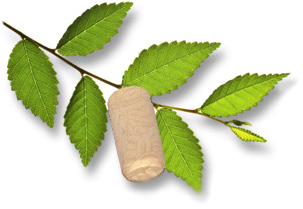 are becoming increasingly popular as a means for sealing up wine bottles. Numbers are sketchy, but it appears that currently around 9 percent of all corked wine bottles in the world are done so with synthetic corks.
are becoming increasingly popular as a means for sealing up wine bottles. Numbers are sketchy, but it appears that currently around 9 percent of all corked wine bottles in the world are done so with synthetic corks.
There’s lots of reasons for this slow increase in popularity, but the main one is pure economics. Over the last decade, wine consumption has increased roughly an average of 4.5% per year. Natural cork producers are finding it difficult to keep up with this increase.
It takes an incredible 25 years for a cork tree to mature into a cork producer. So simply planting more trees does not immediately satisfy the demand that wineries place on the cork producers. The end result is: as the demand for cork increases, so does it’s price. Enter synthetic corks…
Necessity is the mother of invention and the synthetic cork is just one more example of how this timeless quote is so true.
Synthetic corks have been the markets way of solving this supply-and-demand disconnect. And they’ve turned out to be a pretty good wine preservation system. They are affordable, and will consistently and predictably seal up a wine bottle. Many wineries now prefer them over natural cork for this reason alone.
Synthetic corks are basically a spongy plastic that is wrapped in a harder plastic shell. They react to corking devices and to the barrel of the wine bottle in much the same way as a natural cork, so no special equipment is needed. All the plastics involved are pharmaceutical grade and completely safe to use around food products.
We offer synthetic corks as well because of their ease of use and also because of their popularity. Many home winemakers like them simply for the fact that they can be sanitize more completely than natural corks.
———————————————————————————————————
Ed Kraus is a 3rd generation home brewer/winemaker and has been an owner of E. C. Kraus since 1999. He has been helping individuals make better wine and beer for over 25 years.
Is A Grape Press Needed To Making Wine At Home?
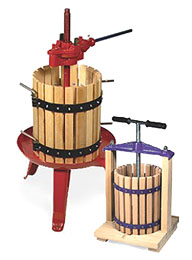 Let me dispel a wine making myth: You do not need a wine press to make wine. You can make perfectly good wine without getting any grape presses involved.
Let me dispel a wine making myth: You do not need a wine press to make wine. You can make perfectly good wine without getting any grape presses involved.
The purpose of having a wine press is a matter of efficiency, not necessity. Grape presses allow you to get more juice from the pulp then you would by just squeezing with your hands or something similar. They do not help you to make a better wine.
For example, in the case of a winery, using grape presses make perfect sense when considering the volume of pulp they are dealing with, a no-brainer. A wine press will pay for itself in the time it saves and the extra juice that is obtained. But for an individual making 5 gallons of wine a year, it’s more likely to not be practical. Better off to lose a little juice than pay for a press.
On the other hand if you’re making 20 or 30 gallons of wine a year, then you might want to start thinking about getting a wine press. Not only do grape presses help you to extract more juice from the pulp, but they can also save you time.
Another thing to consider are the types of wines you’ll want to make. If you think you will be making something other than grape wine such as elderberry, raspberry or even peach wine, the amount of fruit involved is not so great, usually around 15 pounds for a 5 gallon batch.
But if your making wine from wine grapes, then the amount of fruit involved is substantial, typically around 80 pounds of grapes to make 5 gallons. So the types of wines you’ll be making plays into your decision on whether you should go shopping for grape presses or not.
———————————————————————————————————
Ed Kraus is a 3rd generation home brewer/winemaker and has been an owner of E. C. Kraus since 1999. He has been helping individuals make better wine and beer for over 25 years.
Which Wine Ingredient Kits Come With Wine Bottle Labels
Recently, many have been asking us which wine ingredient kits come with wine bottle labels and which do not. So I thought now would be as good of time as any to lay out all the detail about who-has-what when it comes to wine bottle labels.
Most of the wine ingredient kits come with designer wine bottle labels, but some do not. These wine bottle labels list the variety of wine along with some basic information like alcohol percentage by volume and so forth. They are all very attractive and professionally done. They’ll make your wine bottles look like the real deal.
The following is a list of the brands that include, and do not include, wine bottle labels in their kits.
Yes, Wine Labels Included: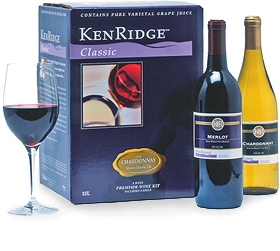
- KenRidge Classic (23 varieties)
- Cheeky Monkey (13 varieties)
- Legacy Premium Blends (22 varieties)
- KenRidge Showcase (21 varieties)
- Vinterra Pure Juice (10 varieties)
- KenRidge Founder’s Series (14 varieties)
No, Wine Labels Are Not Include:
- California Connoisseur (29 varieties)
- European Select (18 varieties)
- Niagara Mist (12 varieties)
- Heron Bay Premium (24 varieties)
- Heron Bay Ultra Premium (15 varieties)
If the wine making kit that you’d like to purchase does not include wine bottle labels, please remember that we do have wine labels that you can purchase separately.
These labels come with various designs that you can choose from. They can also be ran through a computer printer so you can customize them with your personal information.
———————————————————————————————————
Ed Kraus is a 3rd generation home brewer/winemaker and has been an owner of E. C. Kraus since 1999. He has been helping individuals make better wine and beer for over 25 years.
Directions For Successful Wine Making
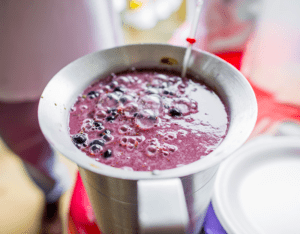 Surfing across the internet for wine recipes these days is fairly easy. Even the most unusual of homemade wines will have a recipe tucked away somewhere on someone’s website. You can find many recipes on our site just as well.
Surfing across the internet for wine recipes these days is fairly easy. Even the most unusual of homemade wines will have a recipe tucked away somewhere on someone’s website. You can find many recipes on our site just as well.
But what’s just as important, but not so easy to find are solid homemade wine instructions. Step-by-step directions that will allow you to successfully make a batch of wine, even if it’s your first time. It makes sense that if you don’t know what to do with a recipe, the recipe is of little value to you.
This is where we come in. We have put together a set of simple, concise homemade wine instructions on our website that will guide you down the path to your first batch of homemade wine.
These directions are basic enough to allow you to apply them to any wine recipe you may find, yet thorough enough to make sure you don’t get lost. Beyond this, we’re always there to help with any question that may arise. We want to see you become a successful home winemaker. It’s in our best interest.
———————————————————————————————————
Ed Kraus is a 3rd generation home brewer/winemaker and has been an owner of E. C. Kraus since 1999. He has been helping individuals make better wine and beer for over 25 years.
Finding The Perfect Gift For The Perfect Wine-Lover
Buying a personalized wine gift for an avid wine-lover can be a very difficult task. Especially when you know absolutely nothing about wine.
The obvious thing would be to pick out a bottle at your local wine shop, but what are the odds that they’d be thrilled with your selection? You could shop for a fancy cork puller, but how cliche…
How about putting a new angle on an old spin and get them a wine making kit. That’s something they would never expect.
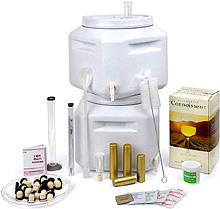 With a home wine making kit they’ll get to experience first-hand how grape juice is turned into wine. It’s an experience that will definitely expand their knowledge of wine.
With a home wine making kit they’ll get to experience first-hand how grape juice is turned into wine. It’s an experience that will definitely expand their knowledge of wine.
We have a wine making kit that keeps things straight-forward and simple. It’s called the California Connoisseur wine making kit. It comes with all the equipment and ingredients they will need to make 6 gallons of wine, including a choice of California grown grape juice, such as Cabernet, Chardonnay, etc.
With this wine making kit they’ll learn how to make white wine or red wine. The directions are clear and assumes that they know absolutely nothing about how wine is made.
It’s fun, and the wine is incredible. We have thousands of repeat customers who buy additional wine making juices. Learn more about the California Connoisseur wine making kit.
———————————————————————————————————
Ed Kraus is a 3rd generation home brewer/winemaker and has been an owner of E. C. Kraus since 1999. He has been helping individuals make better wine and beer for over 25 years.
How To Make Life Easy When Making Wine From Grapes
Making wine from grapes can require a bit of work. This is not only because you are dealing with fresh fruit as opposed to an easy-to-use concentrated juice, but it’s also because you need a lot of grapes to make a batch of wine.
In general, you’ll need around 80 pounds of grapes to make a 5 gallon batch. With most other berries such as blackberries, strawberries, etc., you’ll only need about 15 pounds to make the same 5 gallons.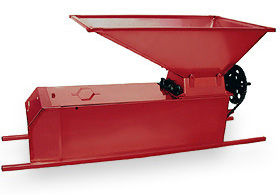
All these grapes need to be taken off the stems as well as crushed. You can get away with doing this all by hand if you are only making 5 gallons or so. But what if you’re trying to make enough grape wine to last you all year, while the grapes are in season? Then you’ll need help.
This is where a grape destemmer comes into play. Not only does the destemmer remove the grapes from the stems, but it also crushes the grape, all in the same process. It’s easy, and it’s quick.
Another option would be to just get a grape crusher and remove the grapes from the stem manually. The advantage to getting just a grape crusher is that most grape crushers can crush other fruits besides grapes, whereas a destemmer is limited to just grapes.
———————————————————————————————————
Ed Kraus is a 3rd generation home brewer/winemaker and has been an owner of E. C. Kraus since 1999. He has been helping individuals make better wine and beer for over 25 years.
What Should I Make My Wine In?
Hello Adventures in Homebrewing,
This year I will have blackberries and I want to get some wine brewing with them. I plan on getting some wine making products from you. Can you tell me what I should be making the wine in. Some say a stone crock others tell me to use a water jug. Can you help?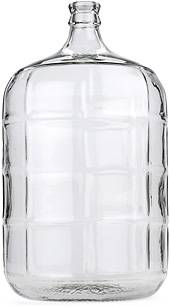
Denise G.
Clinton, MO_____
Dear Denise,
Thanks for the excellent question. Knowing where to start can be confusing, especially when you have so many people telling you so many things.
To have the easiest set-up you will need two different containers, one for the first five or six days of fermentation (primary fermentation), and the other for the rest of the fermentation (secondary fermentation).
You want the primary fermentation to be opened or exposed. A stone crock will work for this purpose, but is not necessary. A plastic fermenter bucket will work just as well. Cover the container with a thin towel or cloth during the fermentation.
The second part of the fermentation will need to be closed off from air. Most people will use carboys for this purpose, which is similar to a water jug. This type of container allows you to attach an air lock to it with a rubber stopper. This will cut off the air from the fermentation but still allow the gasses from the fermentation to escape.
I hope this helps you out.
Ed Kraus
———————————————————————————————————
Ed Kraus is a 3rd generation home brewer/winemaker and has been an owner of E. C. Kraus since 1999. He has been helping individuals make better wine and beer for over 25 years.
Making White Wines From Fresh Grapes
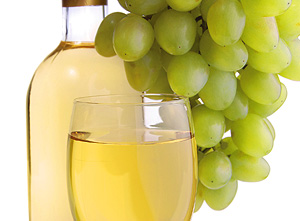 Learning how to make white wine is easy, particularly if you’ve already been making red wines.
Learning how to make white wine is easy, particularly if you’ve already been making red wines.
The main difference is the grape variety being used. You’ll obviously be using a white grape instead of a red grape, otherwise the best you could hope for would be a blush wine.
But beyond this distinction there is another intricacy that has to do with how you will need to process these white grapes.
When making a red wine the grapes are put through a grape crusher and left in the juice (also called must) during the first few days of fermentation. On around the fifth or sixth day the skins and pulp is taken out of the must and then pressed to extract the juice, and then it is discarded.
When making a white wine the grapes are put through the grape crusher and then pressed before the fermentation even starts. Only the white grape juice is in the fermentation. The pulp and skins never see the fermentation. They are put through a wine press and discarded up front.
You may want to take a look at the article Wine Making With Grapes that is on our website. It goes over in better detail the process of making wine from grapes.
———————————————————————————————————
Ed Kraus is a 3rd generation home brewer/winemaker and has been an owner of E. C. Kraus since 1999. He has been helping individuals make better wine and beer for over 25 years.
How Do I Know When My Steam Juicer Is Done Extracting Juice?
When using a steam juicer to extract the juice from grapes, how do you know when it’s done? In other words, how can you tell when the juicer has done all it can do?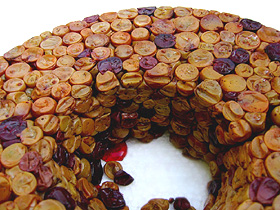
This is the question that was posed to us earlier today by one of our customers in Urbana, Illinois. They are going to make to make some homemade grape wine from Catawbas this year. What a great question!
The steam juicer we offer has a see-through lid. The reason for this is so you can see the condition of the fruit as it is being steam. Through this visual inspection you can tell if the fruit has any more to give or if it has been spent.
In the case of using the steam juicer for processing grapes, you will be able to see that what were once plump grapes are now slowly becoming smaller, shriveled grapes. Eventually, all the grapes will pack to the bottom and form a flat layer of skins. This layer will only be two or three inches high depending on the volume of your steam juicer.
The story is similar for other kinds of fruits as will when using a steam juicer. They will slowly lose their size and compact together at the bottom. Once this occurs, any further steaming is just a waste of time.
———————————————————————————————————
Ed Kraus is a 3rd generation home brewer/winemaker and has been an owner of E. C. Kraus since 1999. He has been helping individuals make better wine and beer for over 25 years.
